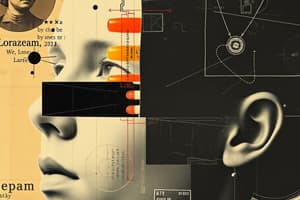Podcast
Questions and Answers
What class of medications does Lorazepam fall under?
What class of medications does Lorazepam fall under?
- Analgesics
- Benzodiazepines (correct)
- Antibiotics
- Antidepressants
What is the expected pharmacological action of Lorazepam?
What is the expected pharmacological action of Lorazepam?
Depresses the CNS by potentiating GABA.
List one therapeutic use of Lorazepam.
List one therapeutic use of Lorazepam.
Sedation.
Which of the following are complications of using Lorazepam? (Select all that apply)
Which of the following are complications of using Lorazepam? (Select all that apply)
Name one contraindication for the use of Lorazepam.
Name one contraindication for the use of Lorazepam.
Lorazepam may cause __________ when used with other CNS depressants.
Lorazepam may cause __________ when used with other CNS depressants.
What is one evaluation of effectiveness for Lorazepam?
What is one evaluation of effectiveness for Lorazepam?
Patients are advised to take Lorazepam continuously for long-term management.
Patients are advised to take Lorazepam continuously for long-term management.
How should Lorazepam be administered?
How should Lorazepam be administered?
What should a nurse assess for in geriatric patients taking Lorazepam?
What should a nurse assess for in geriatric patients taking Lorazepam?
What should a patient do if pregnancy is planned or suspected while taking Lorazepam?
What should a patient do if pregnancy is planned or suspected while taking Lorazepam?
Flashcards are hidden until you start studying
Study Notes
Lorazepam (Ativan) Overview
- Classified as a therapeutic agent used for analgesic adjuncts, antianxiety, and sedative/hypnotic purposes.
- Pharmacologically, it belongs to the benzodiazepine category.
Expected Pharmacological Action
- Acts by depressing the central nervous system (CNS) and enhancing GABA, an inhibitory neurotransmitter.
Therapeutic Uses
- Provides sedation and reduces anxiety.
- Effective in controlling seizures.
Complications (Adverse Reactions/Side Effects)
- CNS Effects: Includes dizziness, drowsiness, lethargy, headache, confusion, and memory impairments.
- Visual: May cause blurred vision.
- Respiratory: Risks of respiratory depression.
- Cardiovascular: Rapid intravenous use can lead to apnea, cardiac arrest, bradycardia, and hypotension.
- Gastrointestinal: Potential side effects include constipation, diarrhea, nausea, and unusual weight gain.
- Dermatological: Possible rashes can occur.
- Miscellaneous: Risks of physical and psychological dependence, tolerance can develop.
Contraindications/Precautions
- Contraindications include hypersensitivity, active CNS depression, uncontrolled severe pain, angle-closure glaucoma, and severe hypotension.
- Precautions required for patients with hepatic, renal, or pulmonary impairment, myasthenia gravis, or a history of drug abuse.
- Pregnancy and lactation warrant careful consideration due to risks of CNS depression in neonates.
Drug Interactions
- Use with caution alongside opioids or other CNS depressants as it may lead to severe sedation or respiratory complications.
- Smoking increases metabolism and decreases effectiveness; certain drugs can alter lorazepam levels, necessitating dose adjustments.
Evaluation of Effectiveness
- Indicators of effectiveness include improved sense of well-being, reduced anxiety, and enhanced sleep patterns.
- Should also assess any postoperative amnesia.
Medication Administration
- Patients should remain supine for eight hours post-parenteral administration.
- Sublingual administration is possible for quicker effects.
- IM doses are to be given deep into muscle at least two hours before surgical procedures.
Nursing Interventions
- Regularly assess the ongoing need for treatment, especially in geriatric patients due to increased sensitivity.
- Monitor for CNS effects and the patient’s safety regarding fall risks.
- High-dose therapy should involve routine evaluations of liver and kidney function.
- Flumazenil (Romazicon) is the designated antidote for overdoses but is contraindicated in seizure disorder.
Client Education
- Emphasize that lorazepam is intended for short-term use and does not address underlying problems.
- Gradual dose reduction is crucial to avoid withdrawal symptoms, including tremors and nausea.
- Promote anxiety-reduction techniques such as exercise and therapy.
- Advise against activities that require alertness until familiar with the medication's effects and warn against alcohol use.
- Stress the importance of follow-up appointments to evaluate the medication's effectiveness.
Studying That Suits You
Use AI to generate personalized quizzes and flashcards to suit your learning preferences.




